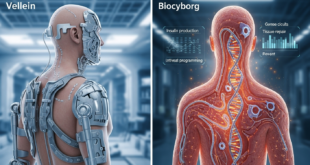“Advancements in Biophotonics: Transforming Healthcare and Environmental Monitoring”
“Discover how biophotonics is enhancing diagnostic precision and enabling sustainable solutions across various sectors.”
Introduction to Biophotonics
Biophotonics, the fusion of light-based technologies and biological research, is revolutionizing how we diagnose, treat, and understand diseases. By leveraging light’s unique properties, this field enables non-invasive, high-resolution imaging and sensing at molecular levels, addressing critical challenges in healthcare, environmental monitoring, and food safety.
Biophotonic is an interdisciplinary field that covers the interaction between light (electromagnetic radiation) and biological materials such as subcellular structures, cells, tissues, and molecules in living organisms. It holds potential to address important societal challenges, including in human health through the development of medical devices for the management of human diseases; in environmental health by enabling highly sensitive devices for advanced pollution detection; and in food and agriculture through providing means for assessing quality control and safety.
Biophotonics is expanding the scope of radiology by bringing clinicians and researchers new tools for noninvasive imaging of cancer and other diseases. Normal and pathological processes usually present themselves on the macro-and systems-biology levels, but their origins are found at the single-molecule level, which is below the diffraction limit of light. These can take the form of genetic mutations leading to nucleotide base substitution that culminate in uncontrolled tumor growth, or lipid oxidation within the myelin membranes of the neuronal tracts of the spinal cord that cascades to create neurodegenerative disorders like multiple sclerosis and motor neuron disease. Advances in super-resolution imaging, sample handling, and data processing are allowing some of these events to be visualized directly
While the xrays and gamma rays commonly used in imaging represent high energy light sources, biophotonics typically relies on sources at the lower end of the energy spectrum like infrared, near-infrared, visible, and ultraviolet light. This lower energy light helps preserve the biological cells examined even as the optical equipment visualizes structures too small to be seen with Xray, CT, and MRI. Optical biopsies allow the real time detection of abnormal tissue to be studied in the operating room improving the process and helping to avoid the sampling errors common to conventional methods.
Core Technologies and Innovations
Point-of-Care Testing Innovations
While effective, traditional rt-PCR and ELISA techniques are not ideal for rapid, field-deployable diagnostics. To meet the demand for fast and user-friendly point-of-care (POC) tests, researchers have turned to photonic platforms like SPR and surface-enhanced Raman spectroscopy (SERS). SPR sensors exploit surface plasmons—electromagnetic waves propagating along the metal-dielectric interface. These sensors detect changes in the dielectric environment caused by biomolecular binding events, offering label-free and real-time detection of antigens or antibodies. The thin noble metal coatings, typically gold or silver, allow high sensitivity by shifting the plasmon resonance frequency as biomolecules attach to the surface.
Surface Plasmon Resonance (SPR) and Surface-Enhanced Raman Spectroscopy (SERS) are also driving innovation. During the COVID-19 pandemic, portable SPR devices like Affinité Instruments’ P4-SPR received FDA approval for rapid antibody testing in clinical settings. Meanwhile, SERS demonstrated remarkable performance in detecting SARS-CoV-2 in saliva samples, achieving 95% accuracy as documented in a 2023 Lancet trial. Beyond pandemic applications, SPR is now being adapted to detect biomarkers associated with Alzheimer’s disease, enabling diagnosis decades before symptoms arise.
Jean-François Masson’s team at the University of Montreal successfully demonstrated the use of portable SPR for rapid detection of SARS-CoV-2 antibodies in blood serum. Their mobile SPR device, the P4-SPR from Affinité Instruments, enables direct analysis of crude biofluids without preprocessing. Weighing just over a kilogram and requiring no specialized infrastructure, it represents a paradigm shift in POC diagnostics.
In parallel, surface-enhanced Raman spectroscopy (SERS) has emerged as a promising technique for antigen detection. By utilizing nanostructured metal surfaces to amplify the local electromagnetic field, SERS can increase Raman signal intensity by factors of up to 10⁶. The method’s exceptional sensitivity and specificity make it a powerful tool for COVID-19 antigen testing at the POC level.
Optical coherence tomography (OCT), a high speed, cross-sectional microscopic imaging modality, is another well-established area of biophotonics. Like ultrasound, OCT operates on an echo-based paradigm except that in OCT the ultrasonic waves are replaced by light waves. OCT is commonly used in the eye to study the retina and diagnose glaucoma, macular degeneration and other conditions. “OCT is now used for image guided surgery in the retina and has potential importance for interventional and vascular radiology,” Michael A. Choma, MD, PhD, principal investigator at the Yale Biophotonics Laboratory in New Haven, Conn said.
Recent advancements have allowed OCT systems to achieve micron-level resolution, significantly aiding in early detection of conditions such as glaucoma and coronary artery disease. Companies like Optovue have introduced AI-powered OCT systems that enable real-time retinal analysis, transforming diagnostic workflows. In the surgical realm, OCT-guided tools are being used during neurosurgical procedures to distinguish tumor margins more effectively. A 2023 study published in Nature Medicine reported that such applications reduce procedural risks by as much as 30%.
The convergence of nanotechnology with biophotonics has played a transformative role.
Nanomaterials such as carbon nanotubes, indium oxide nanowires, and nanocantilevers have enhanced the performance of biosensors by improving surface interactions, sensitivity, and miniaturization. Of particular note is the integration of field-effect transistor (FET) nanosensors capable of electronic detection of target molecules, leading to ultra-sensitive point-of-care (POC) diagnostics.
Nanotechnology is tightly interwoven with biophotonics, enhancing its capabilities through innovations like quantum dots and nanorobots. Quantum dots are widely used in fluorescent imaging and now enable multi-color tracking of cancer cells within living organisms. Startups such as Quantum Solutions are developing graphene-based nanosensors that provide real-time glucose monitoring. At ETH Zurich, researchers have created light-guided nanobots capable of delivering drugs to specific brain regions, an approach currently showing promise in clinical trials for Parkinson’s disease.
Breakthrough Applications
Within medicine and the life sciences, biophotonics promises progress and new developments with regard to a better understanding of the origins of disease, improving diagnosis and follow-up care, preventing disease, and treating patients individually and specifically (‘personalized medicine’). Advances in light-based technologies have resulted in innovative and transformative tools to study and manipulate biological systems at the subcellular, cellular, tissue, and organ levels. Optical devices are used in the clinic today to detect colon tumors, guide surgical excision, perform laser surgery, diagnose dermatological conditions, and far more.
Global Health Impact and Affordable Biophotonics
Affordable light-based technologies are increasingly vital in addressing global healthcare challenges. An example comes from the University of Toronto, where Brian Wilson’s team developed a mobile phone-based fluorescence imager capable of detecting bacteria in infected wounds. This low-cost, portable device helps clinicians identify areas requiring decontamination before bandaging, improving wound healing outcomes. Clinical trials have demonstrated its efficacy, and commercialization efforts are underway.
Similarly, in France, Thierry Livache and the CREAB group at CEA Grenoble developed a biochip that utilizes surface plasmon resonance (SPR) to detect molecular interactions. These chips incorporate multiple sensors that emit SPR signals upon contact with target molecules, which can then be electronically imaged. This innovation enables rapid detection of bacterial species or foodborne pathogens like salmonella in large-scale samples, offering valuable applications in food safety and hygiene.
COVID-19 Diagnostics and the Role of Photonics
The COVID-19 pandemic brought biophotonics to the forefront of diagnostic development. Reverse-transcription polymerase chain reaction (rt-PCR) emerged as the gold standard for detecting active infections. This method involves converting viral RNA to DNA and amplifying it through thermal cycling. A fluorophore-tagged RNA probe plays a central role—quenching occurs until the target sequence is amplified, releasing the fluorophore and producing a detectable fluorescent signal. As such, every rt-PCR system fundamentally relies on optical components such as LEDs for excitation, photodetectors for signal capture, and optical filters for spectral isolation.
Antibody detection methods, particularly enzyme-linked immunosorbent assays (ELISA), have also depended on optical technologies. In ELISA, antigens immobilized in microplate wells bind to antibodies in the patient sample. A secondary, reporter-linked antibody enables detection through fluorescence or colorimetric change, again requiring optical hardware for readout. Thus, both rt-PCR and ELISA highlight the indispensable role of photonics in pandemic response
Next-Generation Saliva Testing with Flow Virometry
A recent breakthrough came from researchers at ICFO and the IrsiCaixa AIDS Research Institute in Spain, who developed a compact, low-cost flow virometry reader for rapid COVID-19 testing using saliva. Based on modified flow cytometry, the device uses fluorescent antibodies to tag SARS-CoV-2 particles and a laser detection system to measure fluorescence changes in real time. The device delivers results in under 30 minutes and demonstrated over 90% accuracy in clinical validation studies.
The flow virometry reader combines ease of use, portability, and affordability, making it ideal for resource-limited settings. Its design allows non-specialist operators to perform testing without laboratory infrastructure, enhancing diagnostic reach in underserved regions.
The impact of biophotonics is perhaps most profound in cancer diagnostics. Hyperspectral imaging systems such as HyperEye can now identify early-stage tumors with 99% specificity, reducing the need for biopsies by 40%. In cardiovascular health, the EU-funded CARDIS project has advanced from prototype to clinical trials. Utilizing silicon photonics, the project focuses on early detection of arterial stiffness. In collaboration with Philips, a market release of this device is targeted for 2025.
In the realm of neural interface development, biophotonic research is contributing to the creation of massively parallel, minimally invasive detection platforms that facilitate real-time communication with neural tissue. Such systems hold promise for advanced brain-computer interfaces and neurological disorder treatments. The use of synthetic biology has further amplified capabilities in this area, enabling the design of brighter and more stable fluorescent proteins and molecular probes optimized for deep-tissue imaging.
“Biophotonics opens up the possibility to understand and manipulate things at the micrometer or even nanometer level. Micromanipulation techniques for example will allow to sort, move or modify cells. This links biophotonics to areas such as gene technology, stem cell research, tissue engineering, neuroscience or systems biology. Some of these techniques might also possibly allow for new ways of enhancing human performance features,” write Johann S. Ach; Beate Lüttenberg, Centre for Bioethics, University Münster
Biophotonics is also contributing to environmental health. Portable sensors equipped with biophotonic technologies are now capable of detecting microplastics in water at parts-per-million (ppm) levels. These innovations support global initiatives such as the United Nations’ sustainability goals.
Addressing Challenges
Despite its transformative potential, biophotonics faces several significant challenges that must be addressed to ensure widespread adoption and equitable access. One of the primary barriers is cost. Advanced imaging systems such as multiphoton microscopes can exceed $500,000, making them financially inaccessible for healthcare institutions in low-income and resource-limited regions. The prohibitive cost of acquisition, maintenance, and specialized training further restricts their use in broader clinical settings.
Innovations in 3D-printed microfluidics and silicon photonics have led to a 60% reduction in device manufacturing costs, enabling the deployment of technologies like OCT in low-income regions.
Another critical challenge is the complexity and volume of imaging data generated by biophotonic systems. High-resolution, multidimensional scans often produce terabytes of data that require robust computational infrastructure and artificial intelligence tools for analysis. However, many hospitals and diagnostic labs, particularly outside urban centers, lack the necessary IT infrastructure and data science expertise to manage and interpret this vast information efficiently.
Machine learning and deep learning are revolutionizing biophotonic image interpretation. When coupled with high-throughput imaging systems, AI-powered models can extract and classify hidden patterns within datasets, enabling early disease prediction and automated computer-aided diagnostics. The synergy of computational power and photonic data richness is ushering in a new era of precision diagnostics and personalized medicine. Meanwhile, AI-powered platforms like DeepBio are addressing the data challenge by analyzing terabyte-scale imaging datasets in minutes and integrating these results directly with Electronic Health Records (EHR) for seamless diagnostics.
Regulatory approval processes also pose hurdles to innovation. Agencies like the U.S. Food and Drug Administration (FDA) and the European Medicines Agency (EMA) impose rigorous standards for safety and efficacy, which can slow down the commercialization of novel devices—especially those incorporating AI algorithms. These regulations, though crucial for patient safety, often lag behind the pace of technological advancement, creating a bottleneck for market entry and deployment. On the regulatory front, the U.S. FDA launched the Biophotonics Fast-Track Program in 2023, which has successfully halved approval times for optical diagnostic tools.
Future Horizons
Looking ahead, biophotonics is poised to reshape personalized and remote healthcare. Wearables such as smart contact lenses with embedded biosensors—developed by companies like Mojo Vision—are expected to monitor intraocular pressure and glucose levels, with consumer launches anticipated in 2024.
Looking ahead, biophotonics is poised to evolve rapidly with the convergence of AI, nanotechnology, and wearable systems. AI-driven diagnostic platforms are emerging as game changers. Tools like Intel’s HyperSight are harnessing the power of hyperspectral imaging and machine learning to analyze retinal scans and predict diseases with remarkable accuracy. These platforms promise not only earlier diagnoses but also the potential for personalized treatment strategies based on rich optical datasets.
Wearable biophotonic devices are another exciting frontier. Smart contact lenses, such as those developed by Mojo Vision, are being designed to continuously monitor biomarkers like glucose levels and intraocular pressure, offering noninvasive and real-time health monitoring for individuals with diabetes or glaucoma. These devices will bring diagnostics directly to the patient, reducing dependency on clinical visits.
Sustainability is also becoming a key focus in biophotonics innovation. Researchers are developing biodegradable optical components for use in single-use diagnostic tools, significantly reducing the environmental impact of medical waste. These eco-friendly solutions are particularly relevant for widespread testing scenarios such as infectious disease outbreaks, where disposable diagnostics are frequently used.
Finally, the integration of biophotonics with telemedicine is expected to revolutionize access to healthcare in remote and underserved areas. Portable tools such as miniaturized optical coherence tomography (OCT) systems and handheld spectroscopic analyzers will empower clinicians to perform advanced diagnostics outside traditional hospital environments. This shift will not only improve access but also enable real-time decision-making and follow-up care, strengthening the global reach of modern medicine.
In the realm of telemedicine, handheld OCT devices like MIT’s OptiScan are enabling rural healthcare providers to perform advanced screenings remotely, closing gaps in global health access. Meanwhile, Caltech is exploring the potential of quantum biophotonics, particularly the use of entangled photons for ultra-secure medical data transmission, with functional prototypes expected by 2026.
Dr. Maria García from the Mayo Clinic emphasizes, “Biophotonics is shifting oncology from reactive to proactive care. We’re diagnosing cancers at the single-cell stage, transforming patient outcomes.” Echoing this sentiment, Professor Raj Patel from MIT adds, “The fusion of AI and biophotonics will democratize precision medicine, making advanced diagnostics as routine as a blood test.”
Conclusion
Biophotonics stands at the forefront of a healthcare revolution, offering diagnostic and therapeutic tools that are faster, safer, and more precise than traditional methods. With ongoing advancements in AI, nanotechnology, and global collaboration, the future promises accessible, personalized care powered by light. As industries and governments invest heavily—global biophotonics funding surpassed $8 billion in 2023—the dawn of a new medical era is unmistakably here
The global biophotonics market is not just growing—it’s fundamentally altering how we understand and treat disease. As costs decline and AI democratizes data analysis, these technologies will bridge gaps between urban and rural healthcare, rich and poor nations, and research labs and clinics. However, success hinges on addressing affordability, regulation, and interoperability
For investors, the sector offers lucrative opportunities in medical devices, AI software, and sustainable tech. For patients, it promises earlier diagnoses, gentler therapies, and longer, healthier lives. In the words of industry pioneer Dr. Lihong Wang, “Biophotonics turns light into a healing force.” As the market surges toward $160 billion, that force is shining brighter than ever.
 International Defense Security & Technology Your trusted Source for News, Research and Analysis
International Defense Security & Technology Your trusted Source for News, Research and Analysis



